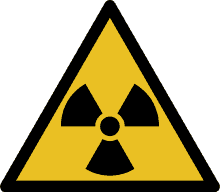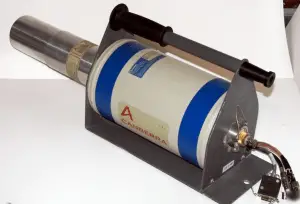
Radiation dosimetry is the measurement, calculation, and assessment of the absorbed doses and assigning those doses to individuals. The science and practice attempt to quantitatively relate specific measures made in a radiation field to chemical and/or biological changes that the radiation would produce in a target. Since there are two types of radiation exposure, external and internal exposure, dosimetry may also be categorized as:
- External Dosimetry. External exposure is radiation from outside our body that interacts with us. In this case, we analyze exposure predominantly from gamma rays and beta particles since alpha particles generally constitute no external exposure hazard because the particles generally do not pass through the skin. Since photons and beta interact through electromagnetic forces and neutrons interact through nuclear forces, their detection methods and dosimetry are substantially different. For example, the radiation source can be a piece of equipment that produces the radiation, like a container with radioactive materials or an x-ray machine. External dosimetry is based on measurements with a dosimeter or inferred from measurements made by other radiological protection instruments.
-

HPGe detector with LN2 cryostat, which can be used in whole-body counters. Source: canberra.com Internal Dosimetry. If the source of radiation is inside our body, we say it is internal exposure. The intake of radioactive material can occur through various pathways, such as ingesting radioactive contamination in food or liquids. Protection from internal exposure is more complicated. Most radionuclides will give you much more radiation dose if they can somehow enter your body than they would if they remained outside. Internal dosimetry assessment relies on various monitoring, bio-assay, or radiation imaging techniques.
Detectors used in Nuclear Power Plants
Radiation dosimeters and detectors can also be categorized according to their purpose. It must be noted that the following devices are not necessary dosimeters, and these devices are used for dosimetry in nuclear power plants:
- Personal Dosimeters. Personal dosimetry is a key part of radiation dosimetry. Personal dosimetry is used primarily (but not exclusively) to determine doses for individuals exposed to radiation related to their work activities. These doses are usually measured by devices known as personal dosimeters.
- Gamma Survey Meters. Portable survey meters are radiation detectors used by radiological technicians to measure ambient dose rates. These portable instruments usually have rate meters. In nuclear facilities, these portable survey meters are typically used by radiation protection technicians.
- Contamination Meters. Contamination meters are instruments for surface contamination measurement. In nuclear facilities, contamination monitors are usually installed at the exit from the controlled areas. These monitors may utilize proportional counters with a large area, thin window detector similar to Hand & Shoe Monitors.
- Full-Body Monitors. Full-Body Monitors, or Whole-Body Monitors, are instruments for surface contamination measurement. They are used for personnel exit monitoring, the term used in radiation protection for checking for external contamination (or surface contamination) of a whole body of a person leaving radioactive contamination controlled area.
- Gamma Spectrometers. A gamma-ray spectrometer (GRS) is a sophisticated device for measuring the energy distribution of gamma radiation. For the measurement of gamma rays above several hundred keV, there are two detector categories of major importance, inorganic scintillators such as NaI(Tl) and semiconductor detectors.
- Radiation Monitoring System. At nuclear facilities, remote radiation monitoring systems (RMS) are installed to monitor radiation levels at selected plant locations. The radiation monitoring system with pre-set alarm levels (e.g., for dose, dose rate, or airborne activity) provides a reliable means of real-time monitoring of the radiological conditions to which a worker is exposed. If these levels are exceeded, alarms are activated, and in some cases, automatic protective functions are initiated. Thus the system serves to:
- Warn of any radiation health hazard
- Give an early warning of a plant malfunction
- Initiate automatic protective functions.
- All data are collected in a radiation protection control room. The radiation monitoring system may gather all information on the radiological conditions at various working areas, as well as voice and visual feedback, with a minimum presence of RP technicians in radiation areas, reducing the dose to such personnel. Several types of radiation monitors are used in the RMS, depending on the source and strength of the radiation source.
- Airborne Contamination Monitors
- Area Monitors
- Iodine Monitors
- In-vent Gas Monitors
Most personal dosimeters in use today mustn’t be absolute instruments but reference instruments, which means they must be periodically calibrated. When a reference dosimeter is calibrated, a calibration factor can be determined. This calibration factor relates the exposure quantity to the reported dose. The validity of the calibration is demonstrated by maintaining the traceability of the source used to calibrate the dosimeter. The traceability is achieved by comparison of the source with a “primary standard” at a reference calibration center. In monitoring individuals, the values of these operational quantities are taken as a sufficiently precise assessment of effective dose and skin dose, respectively, if their values are below the protection limits.
Characteristics of Dosimeters – Key Features
There are many types of dosimeters and detectors, each with limitations. Many factors influence the quality of a dosimeter’s results. Some key considerations when choosing a dosimeter include:
- Type of radiation. Each type of radiation interacts with matter differently, and this consideration is crucial. For doses from neutrons, we cannot use a simple GM counter.
- The energy of radiation. A dosimeter’s response will vary depending on the energy of the radiation and the angle(s) between the source and the dosimeter’s detector.
- Fading. A dosimeter’s signal can be lost or fade over time, caused by external factors such as temperature, light, and humidity.
- Direct reading. Sometimes, it is of the highest importance that the dosimeter can give a continuous readout of the cumulative dose and current dose rate and warn the person wearing it when a specified dose rate or a cumulative dose is exceeded.
- Minimum measurable dose. The lowest dose can be measured with a certain specified confidence level.
- Ruggedness and ease of wear. Dosimeters differ in their ability to withstand severe environmental conditions. Some are heavy for a given purpose, and some are smaller, lighter, and more portable.
As can be seen, radiation dosimetry is very difficult since no single dosimeter will have every one of these characteristics. Therefore, a dosimeter user must understand the environment where the instrument will be used. In most practical situations, dosimeters provide reasonable approximations to the personal dose equivalent, Hp(d), at least at the location of the dosimeter. It must be noted that the personal dose equivalent generally overestimates the effective dose. On the other hand, this procedure is valid only at low doses and under the assumption of a uniform whole-body exposure. However, this procedure might not be sufficient for high personal doses approaching or exceeding the annual dose limit or in strongly inhomogeneous radiation fields.
See also: The Radiation Dosimeters for Response and Recovery Market Survey Report. National Urban Security Technology Laboratory. SAVER-T-MSR-4. <available from: https://www.dhs.gov/sites/default/files/publications/Radiation-Dosimeters-Response-Recovery-MSR_0616-508_0.pdf>.
Types of Dosimeters
Film Badge Dosimeters
Film badges are small portable devices for monitoring cumulative radiation dose due to ionizing radiation. The principle of operation is similar to X-ray pictures. The badge consists of two parts: photographic film and a holder. The film is contained inside a badge. The piece of photographic film is sensitive material, and it must be removed monthly and developed. The more radiation exposure, the more blackening of the film. The blackening of the film is linear to the dose, and doses up to about 10 Gy can be measured.
See also: Film Badge Dosimeter
TLD – Thermoluminescent Dosimeter
A thermoluminescent dosimeter, abbreviated as TLD, is a passive radiation dosimeter that measures ionizing radiation exposure by measuring the intensity of visible light emitted from a sensitive crystal in the detector when the crystal is heated. The intensity of light emitted is measured by the TLD reader, depending on the radiation exposure. Thermoluminescent dosimeters were invented in 1954 by Professor Farrington Daniels of the University of Wisconsin-Madison. TLD dosimeters apply to situations where real-time information is not needed. Still, precise accumulated dose monitoring records are desired for comparison to field measurements or for assessing the potential for long-term health effects.
See also: TLD – Thermoluminescent Dosimeter
EPD – Electronic Personal Dosimeter
An electronic personal dosimeter is a modern dosimeter that can give a continuous readout of cumulative dose and current dose rate and warn the person wearing it when a specified dose rate or a cumulative dose is exceeded. EPDs are especially useful in high-dose areas where the residence time of the wearer is limited due to dose constraints.
The electronic personal dosimeter, EPD, can display a direct reading of the detected dose or dose rate in real-time. Electronic dosimeters may be used as supplemental dosimeters as well as primary dosimeters. The passive and electronic personal dosimeters are often used together to complement each other.
See also: EPD – Electronic Personal Dosimeter